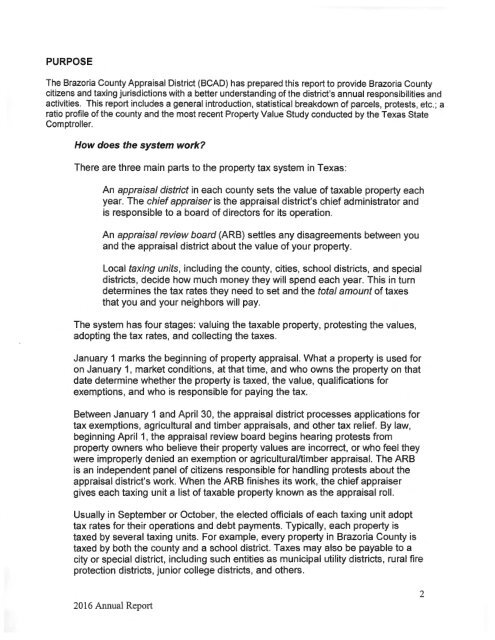Brazoria County Appraisal District
95Ju4f
95Ju4f
You also want an ePaper? Increase the reach of your titles
YUMPU automatically turns print PDFs into web optimized ePapers that Google loves.
PURPOSE<br />
The <strong>Brazoria</strong> <strong>County</strong> <strong>Appraisal</strong> <strong>District</strong> (BCAD) has prepared this report to provide <strong>Brazoria</strong> <strong>County</strong><br />
citizens and taxing jurisdictions with a better understanding of the district's annual responsibilities and<br />
activities. This report includes a general introduction, statistical breakdown of parcels, protests, etc.; a<br />
ratio profile of the county and the most recent Property Value Study conducted by the Texas State<br />
Comptroller.<br />
How does the system work?<br />
There are three main parts to the property tax system in Texas:<br />
An appraisal district in each county sets the value of taxable property each<br />
year. The chief appraiser is the appraisal district's chief administrator and<br />
is responsible to a board of directors for its operation.<br />
An appraisal review board (ARB) settles any disagreements between you<br />
and the appraisal district about the value of your property.<br />
Local taxing units, including the county, cities, school districts, and special<br />
districts, decide how much money they will spend each year. This in turn<br />
determines the tax rates they need to set and the total amount of taxes<br />
that you and your neighbors will pay.<br />
The system has four stages: valuing the taxable property, protesting the values,<br />
adopting the tax rates, and collecting the taxes.<br />
January 1 marks the beginning of property appraisal. What a property is used for<br />
on January 1, market conditions, at that time, and who owns the property on that<br />
date determine whether the property is taxed , the value, qualifications for<br />
exemptions, and who is responsible for paying the tax.<br />
Between January 1 and April 30, the appraisal district processes applications for<br />
tax exemptions, agricultural and timber appraisals, and other tax relief. By law,<br />
beginning April 1, the appraisal review board begins hearing protests from<br />
property owners who believe their property values are incorrect, or who feel they<br />
were improperly denied an exemption or agricultural/timber appraisal. The ARB<br />
is an independent panel of citizens responsible for handling protests about the<br />
appraisal district's work. When the ARB finishes its work, the chief appraiser<br />
gives each taxing unit a list of taxable property known as the appraisal roll.<br />
Usually in September or October, the elected officials of each taxing unit adopt<br />
tax rates for their operations and debt payments. Typically, each property is<br />
taxed by several taxing units. For example, every property in <strong>Brazoria</strong> <strong>County</strong> is<br />
taxed by both the county and a school district. Taxes may also be payable to a<br />
city or special district, including such entities as municipal utility districts, rural fire<br />
protection districts, junior college districts, and others.<br />
2016 Annual Report<br />
2


